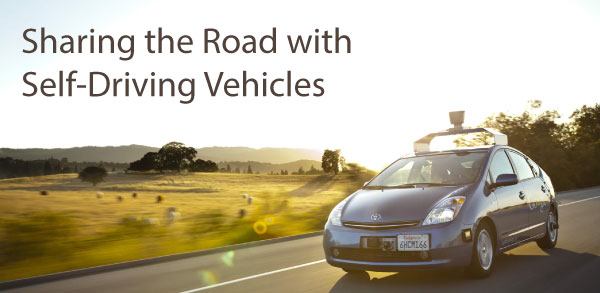Turn signals, brake lights and horns are useful features on a car, but they’re not the only ways we communicate with other drivers. We flash our headlights to signal it’s OK for another vehicle to go ahead, wave to thank another driver for letting us into their lane, or make eye contact with pedestrians to let them know we see them.
But what happens when it’s software, not humans, driving the other cars? Self-driving cars (SDCs) from auto and tech companies have already driven millions of miles under software control. Though there are still legislative hurdles and liability questions that need to be addressed before SDCs are available to consumers, you still might spot one on a test drive. Below you will find some tips on what to expect—and how to communicate—if you’re sharing the road with a self-driving vehicle.
If you have any questions on how your insurance will handle self-driving cars, please don’t hesitate to give our office a call.
Check for labels and sensors
You can spot some self-driving cars by sensors mounted on the roof or hood, but others simply have a label on the side. “Most likely, other drivers won’t be able to tell a self-driving car apart from a regular car. .
At this stage, SDCs still have humans riding along in the driver’s seat, so while you might be able to identify the car, you may not be able to tell whether it’s in autonomous mode. This means there should be no need for other drivers to behave any differently around self-driving cars.
Be patient behind the wheel
Most self-driving cars are programmed to drive cautiously. The cars are designed to be “very conservative” —always maintaining the speed limit and slowing down for yellow lights. In doing cross-country automated drives, many auto companies observed a number of unhappy human drivers because the vehicles were driving the posted speed limits. (One California resident, where Google is testing autonomous vehicles on public roads, complained that “Google cars drive like your grandma.”)
This impatience may account for human drivers’ less-than-stellar record versus self-driving cars; recent reports from the California DMV found that all accidents involving autonomous cars in the state were caused by human driver error. If you find yourself behind a self-driving car, pay attention to its speed, don’t follow too closely and wait for it to proceed at stoplights and intersections.
Keep cycling as usual
Not only do self-driving cars have sensors that detect movement (often a combination of cameras, radar and lidar, which is similar to radar but uses laser pulses instead of radio waves), they’re programmed to make human-like decisions. For example, if the car detects a cyclist, the vehicle will either slow down until it’s safe to pass, or pass if it detects that the opposing lane is open and clear for it to go around.
Trust the cars when on foot
When it comes to managing distractions, self-driving cars have the advantage over human drivers—their electronic eyes never drift to phones, the radio or passengers. And since they are still at the testing stage, safety is the manufacturers’ main priority. So they’re programmed to be careful at crosswalks. Give them time to brake before you cross the street, but trust that they can see you—even if there’s no human driver to make eye contact and wave you across.



